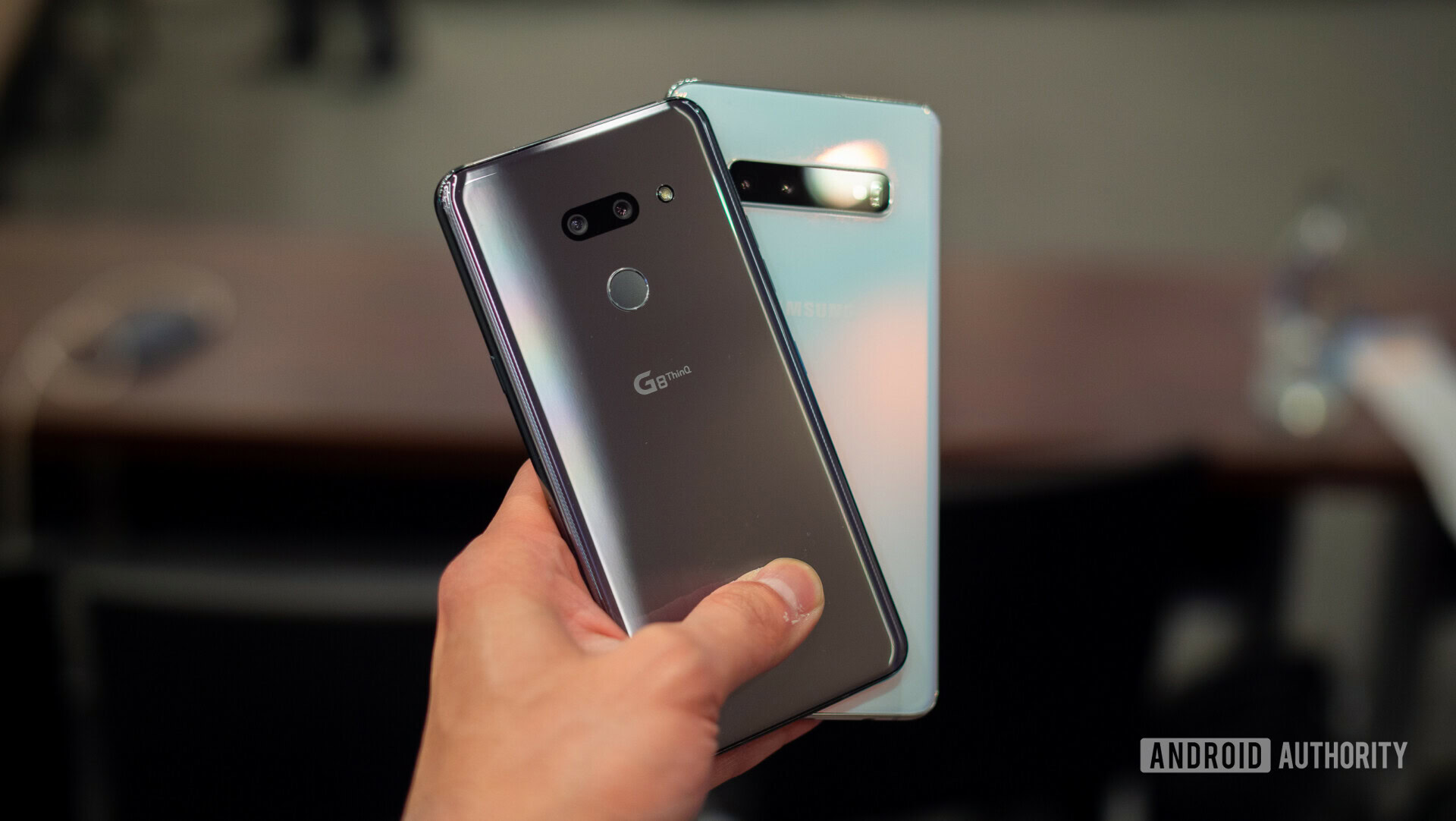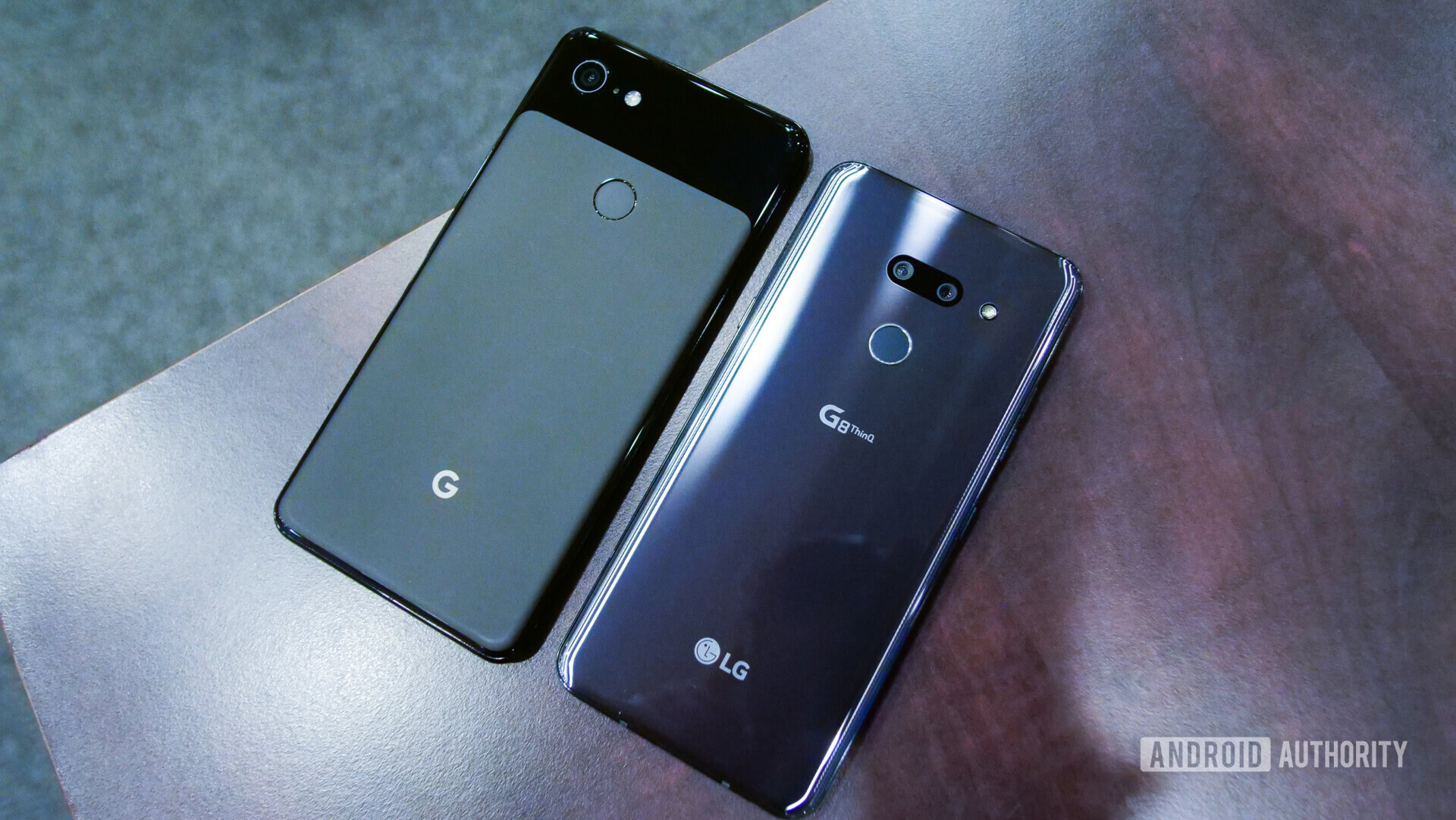Affiliate links on Android Authority may earn us a commission. Learn more.
LG G8 ThinQ vs the competition

LG is finally hoping to recapture its previous form with a couple of smartphone launches at MWC this year. The new LG G8 ThinQ builds on the decent G7 with a number of new features. Although, the handset will have to make a name for itself against LG’s other flagship announcement at MWC, the LG V50 ThinQ 5G. So how does the handset compare some of the best smartphones around and the latest 2019 releases?
The new Samsung Galaxy S10 Plus sets a high bar for 2019 flagships, as does last year’s HUAWEI Mate 20 Pro. As a reference point, we’ve also included Google’s Pixel 3 XL to see whether the LG G8 ThinQ can go above and beyond Google’s vision for Android smartphones.
Read more: LG V50 ThinQ is here: Everything you need to know
Hardcore specs for hardcore users
The LG G8 ThinQ joins a growing list of phones, including the Samsung Galaxy S10 and Xiaomi Mi 9, offering Qualcomm’s cutting edge 7nm Snapdragon 855 processing package. With bigger more powerful CPU cores, enhanced graphics, AI silicon, and a blazing fast LTE modem, there’s nothing to complain about here. Last year’s HUAWEI Mate 20 Pro remains a competitive option though, boasting its own 7nm Kirin 980 chip with similar Cortex-A76 CPU cores, dedicated AI silicon, but a slightly weaker Mali-G76 MP10 GPU.
This generation of chips are faster and, more importantly, more power efficient than last year’s commonplace 10nm Snapdragon 845. Although we should note that 2018’s flagship phones weren’t slouching around. There’s no reason not to pick up a Google Pixel 3 XL or another 2018 flagship based on processing abilities.
| LG G8 ThinQ | Samsung Galaxy S10 Plus | HUAWEI Mate 20 Pro | Google Pixel 3 XL | |
|---|---|---|---|---|
Display | LG G8 ThinQ 6.1-inch OLED panel 3,120 x 1,440 resolution 564ppi 19.5:9 aspect ratio | Samsung Galaxy S10 Plus 6.4-inch AMOLED panel 3,040 x 1,440 resolution 19:9 aspect ratio | HUAWEI Mate 20 Pro 6.38-inch curved OLED 3,120 x 1,440 resolution 19.5:9 aspect ratio | Google Pixel 3 XL 6.3-inch P-OLED 2,960 x 1,440 resolution 18.5:9 aspect ratio |
CPU | LG G8 ThinQ 7nm octa-core Snapdragon 855 | Samsung Galaxy S10 Plus 8nm octa-core Exynos 9820 / 7nm octa-core Snapdragon 855 | HUAWEI Mate 20 Pro 7nm octa-core Kirin 980 | Google Pixel 3 XL 10nm, octa-core Qualcomm Snapdragon 845 |
GPU | LG G8 ThinQ Adreno 640 | Samsung Galaxy S10 Plus Mali-G76 MP12 / Adreno 640 | HUAWEI Mate 20 Pro Mali-G76 MP10 @ 720MHz | Google Pixel 3 XL Adreno 630 |
RAM | LG G8 ThinQ 6GB | Samsung Galaxy S10 Plus 8/12GB | HUAWEI Mate 20 Pro 6GB | Google Pixel 3 XL 4GB |
Memory | LG G8 ThinQ 128GB | Samsung Galaxy S10 Plus 128/512GB / 1TB | HUAWEI Mate 20 Pro 128GB | Google Pixel 3 XL 64/128GB |
MicroSD | LG G8 ThinQ Yes, up to 2TB | Samsung Galaxy S10 Plus Yes, up to 512GB | HUAWEI Mate 20 Pro Yes, up to 256GB (nano memory card) | Google Pixel 3 XL No |
Battery | LG G8 ThinQ 3,500mAh Non-removable | Samsung Galaxy S10 Plus 4,100mAh Non-removable | HUAWEI Mate 20 Pro 4,200mAh Non-removable | Google Pixel 3 XL 3,430mAh Non-removable |
In terms of RAM, the LG G8 ThinQ’s 6GB pool is plenty enough. Even though the Samsung Galaxy S10 Plus comes in an option offering double the capacity, that won’t provide any tangible difference to handset performance. Even the Pixel 3 XL’s 4GB RAM is decent enough.
The LG G8 also sits in familiar territory with its 128GB internal storage capacity. That’s the same amount on offer from the Mate 20 Pro and the biggest Pixel 3 XL variety. Although Samsung offers huge 512GB and 1TB options, the LG G8’s support for 2TB microSD cards still makes this phone a winner for the insatiable videographer or movie watcher.
Wrapping back around the table to displays, we see that QHD+ is the only choice across all of these models. Although a number of these phones default to an FHD+ software resolution to save on battery life. The G8 and Mate 20 boast the longest 19.5:19 aspect ratio, but any of these are fine for content playback, so long as you don’t mind the black borders. Where we might see a more meaningful difference is in the panel technology. LG’s OLED versus Samsung’s AMOLED is a hot contest that Samsung has won in previous generations. We’ll be testing these technologies thoroughly in our lab ASAP.
Tying all this technology together is a 3,500mAh battery inside the LG G8. That’s notably smaller than the 4,100mAh and 4,200mAh cells available in Samsung’s and HUAWEI’s flagships, but in the same areas as the Pixel 3 XL. The larger cells should certainly get you onto a second day of moderate use, while most users will probably consume nearly all the LG G8’s juice by the end of a single day.

Classic cameras, new twists
LG has long positioned itself as a phone for content creators. Offering enhanced video recording capabilities and flexible camera shooting configurations. However, the phone has never managed to stand out against the excellent camera packages offered by HUAWEI, Samsung, and Google.
Low-light performance has repeatedly been a sore spot for LG, so perhaps the f/1.5 12MP main sensor will address this problem and level the playing field. Although we’ll reserve judgment for a head-to-head shootout. This year’s effort sees the return of the ultrawide snapper. However, both Samsung and HUAWEI offer the same capabilities, plus an additional telephoto lens for long distance shots. If you’re after similar from LG, you’ll have to opt for the LG G8s model. All of these phones are more flexible than the Pixel 3 XL’s single shooter, but it’s hard to argue with the consistency of Google’s camera.
On the front, LG has introduced a Time-of-Flight depth-sensing camera for superior bokeh capture. Samsung is offering a similar technology but only as part of its much more expensive Galaxy S10 5G model.
| LG G8 ThinQ | Samsung Galaxy S10 | HUAWEI Mate 20 Pro | Google Pixel 3 XL | |
|---|---|---|---|---|
Camera | LG G8 ThinQ Rear: 16MP f/1.9 ultrawide + 12MP f/1.5 standard Front: 8MP f/1.7 standard + Z Camera (ToF) | Samsung Galaxy S10 Rear: 16MP f/2.2 ultrawide + 12MP f/1.5 and f/2.4 dual pixel with OIS + 12MP OIS telephoto f/2.4 Front: 10MP f/1.9 dual pixel | HUAWEI Mate 20 Pro Rear: 40MP (wide-angle 27mm) f/1.8 20MP (ultra-wide-angle 16mm) f/2.2 8MP (3x Telephoto 80mm) f/2.4 with OIS Front: 24MP (f/2.0, FF) | Google Pixel 3 XL Rear: 12.2MP f/1.8 sensor Front: 8.2MP f/2.2 sensors + wide-angle sensor and depth sensor |
IP Rating | LG G8 ThinQ IP68 | Samsung Galaxy S10 IP68 | HUAWEI Mate 20 Pro IP67 | Google Pixel 3 XL IP67 |
Charging | LG G8 ThinQ Fast Wireless Charging 2.0 | Samsung Galaxy S10 Fast Wireless Charging 2.0 Wireless PowerShare USB Type-C | HUAWEI Mate 20 Pro 40W HUAWEI SuperCharge 15W Wireless Charging USB Type-C | Google Pixel 3 XL Wireless Charging USB Power Delivery USB Type-C |
Connectivity | LG G8 ThinQ Wi-Fi Bluetooth 5 3G, LTE 4G | Samsung Galaxy S10 Wi-Fi 6 Bluetooth 5.0 Cat20 LTE, 2.9Gbps, 4x4 MIMO NFC | HUAWEI Mate 20 Pro Wi-Fi 802.11ac Bluetooth 5.0 NFC | Google Pixel 3 XL Wi-Fi 802.11ac Bluetooth 5.0 NFC |
Software | LG G8 ThinQ Android 9.0 Pie | Samsung Galaxy S10 Android 9 Pie Samsung One UI | HUAWEI Mate 20 Pro Android 9 Pie EMUI 9 | Google Pixel 3 XL Android 9 Pie |
Dimensions and weight | LG G8 ThinQ 151.9 x 71.8 x 8.4mm 167g | Samsung Galaxy S10 149.9 x 70.4 x 7.8mm 157g | HUAWEI Mate 20 Pro 157.8 x 72.3 x 8.6mm 189g | Google Pixel 3 XL 76.7 x 158.0 x 7.9mm 184g |
In terms of other features, IP water resistance can be found throughout these models. The Galaxy S10 and LG G8 offer slightly more water protection with an IP68 rather than IP67 rating. The two models also share Fast Wireless Charge 2.0 technology for speedier over the air top-ups. Although both the Mate 20 Pro and Pixel 3 XL boast their own speedy wireless charging technologies. Speaking of charging, the HUAWEI Mate 20 Pro still sets the bar for wired fast charging, clocking in at a huge 40W of power. Fortunately, LG retains its MIL-STD 810G compliance, as well as including an external DAC and OLED screen speaker to set itself apart.
There’s no fancy in-display fingerprint sensor in the LG G8. The phone sticks with a capacitive option like the Pixel 3, instead of the ultrasonic technology that powers Samsung’s Galaxy S10 solution. However, the G8 does offer 3D face unlock security thanks to its depth-sensing camera, which Samsung and Google do not. The HUAWEI Mate 20 Pro boasts its own 3D face-mapping tech, but that sits inside a much bigger notch. It also boasts an intriguing Hand ID vein recognition technology as a novel, alternative solution.
As we said when looking ahead to LG’s 2019, the company needs a flagship that can shake up its fortunes and grab it some real market appeal. The LG G8 ThinQ certainly improves on the G7 formula, although a few of the new features feel rather gimmicky. As good as the phone is, it’s hard not to come to the conclusion that the G8 will probably end up overshadowed by the LG V50 ThinQ 5G too. If for no other reason than the growing hype around 5G.
Whether or not the LG G8 ThinQ is worth a purchase almost certainly probably boil down to price, and how well the camera performance turns out. The LG G8 nails the core specifications and includes plenty of worthy extras. However, the Galaxy S10 and Mate 20 Pro offer style as well as substance. For that reason, they are likely to be more compelling to a wider audience than LG’s offering.
What do you think about the LG G8 Thinq? Does LG’s latest flagship have what it takes to stand out from an increasingly impressive crowd of flagships?